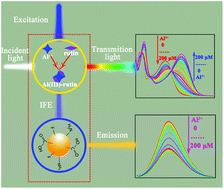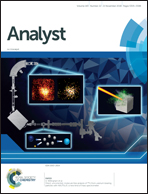A carbon dots/rutin system for colorimetric and fluorimetric dual mode detection of Al3+ in aqueous solution
Abstract
In this work, colorimetric and fluorimetric dual mode detection of Al3+ in aqueous solution was achieved using a carbon dots/rutin (CDs/rutin) coexisting system. Upon addition of Al3+, a yellow Al(III)–rutin complex was formed without any interaction between Al3+ and the carbon dots (CDs). As a result, a new absorption peak of the complex at 430 nm increased while the peak of rutin at 360 nm decreased. Therefore, a ratiometric colorimetric method for the detection of Al3+ was built on a good linear relationship between the absorbance ratio (A430 nm/A360 nm) and the concentration of Al3+ in a wide linear range from 2.0 to 40.0 μM, with a limit of detection (LOD) as low as 0.38 μM. More interestingly, the excitation spectrum of the CDs overlapped with the absorption band of the Al(III)–rutin complex, resulting in an inner filter effect on the fluorescence of the CDs. Accordingly, a fluorimetric approach was developed on an excellent linear relationship between (F0 − F)/F0 and the concentration of Al3+ in the range from 0.8 to 20.0 μM, with an LOD of 0.32 μM. Finally, the spiked Al3+ in real samples (tap water and lake water) was recovered by the as-proposed dual mode detection with high accuracy.



 Please wait while we load your content...
Please wait while we load your content...